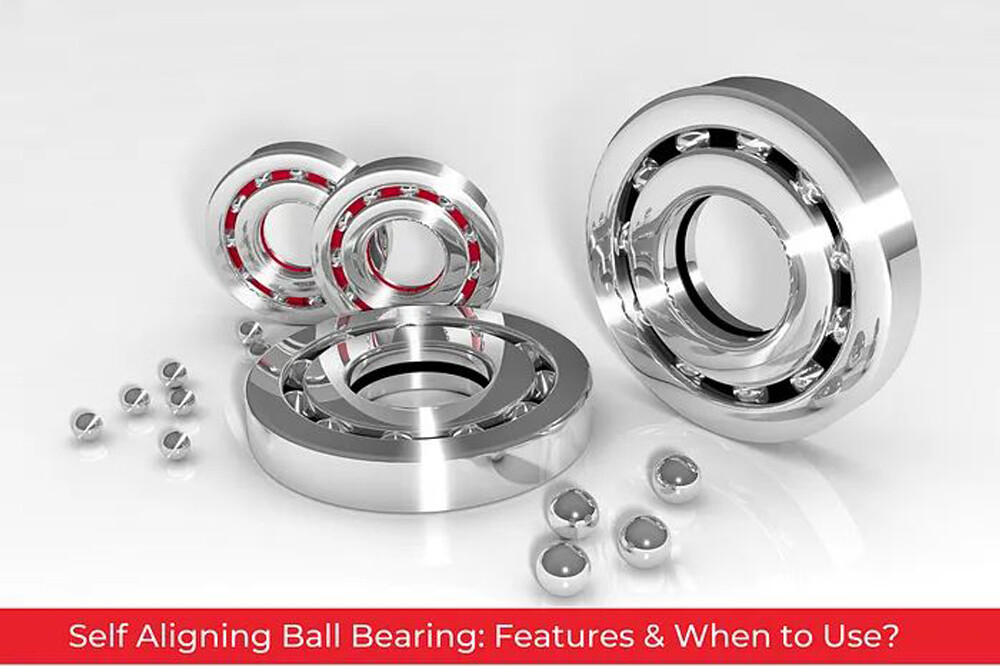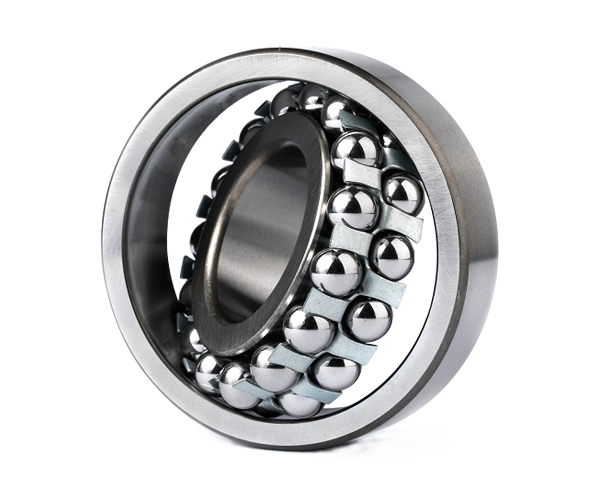
Bearing Manufacturer & Supplier
Specialize in ball bearings, roller bearings, thrust bearings, thin section bearings etc.
The Ultimate Guide to Self-Aligning Ball Bearings
Self-aligning ball bearings are special double-row ball bearings that handle shaft misalignment and provide high load capacity and stiffness to self-adjust to changing application environments. Self-aligning ball bearings are common stock bearings. Due to their unique design, self-aligning ball bearings are the primary bearing type to consider when operating in harsh environments or in applications requiring precise alignment. Self-aligning ball bearings maintain performance even if there is slight misalignment between shaft and housing, for example in the automotive, aerospace and industrial machinery sectors. This comprehensive guide helps you explore the design, applications, advantages and disadvantages of self-aligning ball bearings, and when to use them.
Table of Contents
ToggleWhat are self-aligning ball bearings?
Precision and misalignment are critical for the smooth operation of machinery. Great designers construct an adaptive ball bearing that can meet harsh environments – self-aligning ball bearings. Self-aligning ball bearings have a concave spherical outer ring raceway, and the inner ring, ball and cage can deflect around the center to provide self-aligning performance. The bearing’s self-aligning feature compensates for small angular misalignments of the shaft or housing, typically ranging from 2.5° to 3°, depending on the bearing series. Self-aligning ball bearings are ideal for applications where misalignment is an issue between the shaft and housing without losing energy or creating additional friction. However, due to the relatively small contact angle of these bearings, the axial load capacity is not as high as that of angular contact bearings. Self-aligning ball bearings can bear radial loads and axial loads in different directions, and their inner rings have cylindrical holes or tapered holes. Self-aligning ball bearings are available as open or with seals.

Self-aligning ball bearings have the lowest friction of all ball bearings, and their design allows them to run cool even at high speeds. In addition, self-aligning ball bearings with the suffix 2RS have contact seals (NBR) on both sides. Sealed self-aligning ball bearings also protect them from dirt and other contaminants. These seals allow operation in an operating temperature range of -40°C to +100°C and quickly withstand temperatures up to +120°C, providing reliable protection for your machinery. There are three types of self-aligning ball bearing cages: steel plate stamped cages, polyamide molded cages, and copper alloy cages. Therefore, self-aligning ball bearings are used in various industries such as automotive, mining, food processing, textile industry, etc.
Advantages of self-aligning ball bearings
Misalignment tolerance. The main advantage of self-aligning ball bearings is their ability to tolerate misalignment. This feature reduces stress on mechanical components, simplifying installation and extending the life of the machine.
Extended service life. Self-aligning ball bearings can significantly extend their service life by reducing wear on the bearing and surrounding components. This means replacement and maintenance are less frequent, reducing downtime and costs.
Various applications. Self-aligning ball bearings are versatile and can be adapted to a variety of applications. From conveyors and pumps to fans and agricultural machinery, these bearings have proven their worth in a wide range of industries.
Enhanced reliability. The self-aligning properties of these bearings help improve the overall reliability of the machinery in which they are used. They can handle the inevitable variations and vibrations during operation without compromising performance.
Limitations of self-aligning ball bearings
Although we mentioned above that self-aligning ball bearings have unique advantages, they also have limitations. Self-aligning ball bearings are not designed for axial loads, which means they are not suitable for applications that generate large thrust forces. If heavy loads are required, it is recommended to use spherical roller bearings with the same self-aligning performance. Additionally, their optimal speed range is limited to low to medium speeds.
Applications of self-aligning ball bearings
Self-aligning ball bearings accommodate static and dynamic misalignment and provide excellent performance in high-speed applications. Loose conformity between the balls and outer ring reduces friction and therefore frictional heat. Therefore, self-aligning ball bearings produce less friction than any other type of rolling bearing. Runs at lower temperatures even at high speeds. Because less heat is generated, bearing temperatures are lower, resulting in longer bearing life and longer maintenance intervals. Additionally, self-aligning ball bearings reduce noise and vibration levels, which is why they are commonly found in fans. The versatility of self-aligning ball bearings plays an irreplaceable role in many fields.

Automobile industry. Self-aligning ball bearings are used in automobile steering systems, suspension assemblies and transmissions. Misalignment and real-time changing loads are common on these critical components.
Mining and construction. Self-aligning ball bearings are used in heavy machinery such as mining, construction and excavators where they can withstand challenging heavy loads.
Textile Machinery – The ability to accommodate shaft misalignment makes these bearings suitable for use in textile machinery components, ensuring smooth operation even during high-speed spinning and weaving processes.
Transport machinery. Conveyor systems and material handling equipment benefit from the operational versatility and load-carrying capacity of self-aligning ball bearings.
Agriculture. In agricultural machinery such as tractors and combine harvesters, where uneven terrain and sudden jumps are common, self-aligning ball bearings help achieve reliable performance and reduce maintenance requirements.
Installation, maintenance and troubleshooting
Following proper installation, maintenance and monitoring procedures is important to ensure smooth operation and long service life of self-aligning ball bearings. Failure to do so may result in premature bearing failure, unplanned downtime and reduced machine efficiency. Therefore, in order to maximize the benefits of bearings, established best practices must be followed.
Lubrication: Lubrication is the primary consideration in improving bearing performance. Proper lubrication reduces friction, heat and wear. Lubricant selection, viscosity and replenishment intervals should be based on a comprehensive tribological analysis. Insufficient lubrication is believed to be the main cause of approximately 36% of bearing failures.
Monitor regularly. The use of advanced monitoring technologies, such as vibration analysis and thermal imaging, can help detect bearing anomalies early. This proactive approach has been proven to reduce maintenance costs by up to 50% and increase machinery uptime by nearly 30%. By analyzing vibration patterns and temperature changes, incipient problems can be identified and resolved before they escalate into major problems.
Seal. Reducing contamination is critical to extending bearing life. An effective sealing mechanism prevents the penetration of contaminants and particles, significantly reducing wear. In addition, regular visual detection of wear, damage or lubrication abnormalities plays a key role. Regular inspections can extend bearing life by up to 2.5 times.
How to choose self-aligning bearings?
Choosing the right self-aligning bearing for your machinery is a crucial decision. When considering self-aligning ball bearings, factors such as expected misalignment, rotational speed, load type, load magnitude, tolerances and bearing dimensions must be evaluated. These parameters will guide you in selecting the appropriate bearing series and size to ensure optimal performance and service life.
Dislocation. When a shaft may be misaligned, bearings with self-aligning capabilities are often the first option. Self-aligning ball bearings are a great solution. Keep in mind that most self-aligning bearings can only handle misalignment of 3 degrees or less. Any misalignment above 3 degrees requires custom bearings.
Speed. Self-aligning bearings can operate at higher speeds than traditional bearings. For high-speed applications, self-aligning bearings are an excellent choice. However, lubrication and bearing size are also major factors affecting speed. Therefore, it is also important to consider the speed, lubrication type and load requirements of the machine. Grease lubrication operates slowly than oil lubrication.
load. Self-aligning bearings are suitable for radial loads, but due to the small contact angle, they are not suitable for larger axial loads. This must be taken into consideration when selecting bearings.
Seal type and lubrication. If the bearing has an open or shielded seal, a lubrication procedure may be required. Otherwise, sealed bearings are usually pre-lubricated.
Size. Select the appropriate bearing size based on speed requirements, load type, load size, shaft size and housing size.
Conclusion
Self-aligning ball bearings are a creative invention of engineers. Their ability to accommodate misalignment and provide reliability in a variety of applications makes them a jewel in the manufacturing industry. Self-aligning ball bearings have an automatic correction mechanism in the event of shaft deflection or housing misalignment, reducing the risk of catastrophic failure. The use of self-aligning ball bearings in industrial applications can improve operating efficiency and extend bearing and machinery life. However, it is important to understand the limitations of self-aligning ball bearings and choose them wisely based on your specific machine requirements. In addition, the development of fatigue resistance and corrosion resistance of self-aligning ball bearings has benefited from advances in bearing materials. Special bearing steels, stainless steels, ceramics and advanced heat treatment processes further improve bearing performance under extreme operating conditions. For best results, consult Aubearing’s bearing experts who can provide guidance and provide the right self-aligning ball bearing for your needs.
